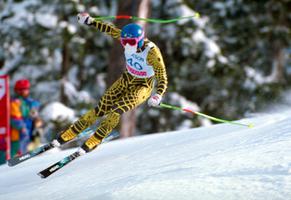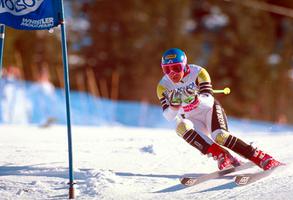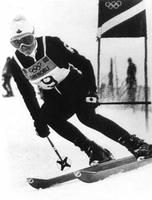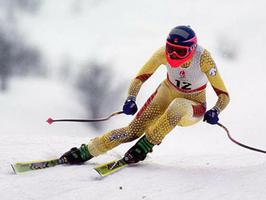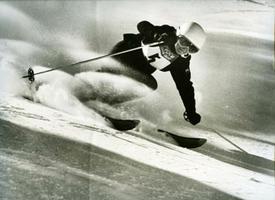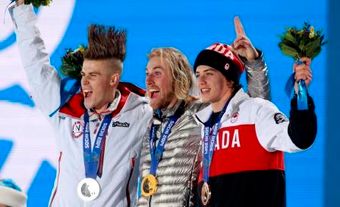It is probable that the first skiers in Canada were the Norse, who established several East Coast settlements about 1000 AD. Although no direct proof has been found, it would be remarkable if they had not brought their then 4000-year-old tradition of winter travel on long wooden sticks (skath) with them.
The birth of modern skiing in North America, nearly 1000 years later, can be credited to their direct descendants. Scandinavian prospectors and miners participating in the gold rushes of the mid-1800s used wooden "snowshoes" or "gliding shoes" up to 4 m long as a means of travel as well as for highly competitive professional downhill racing competitions. From 1856 to 1869, the Norwegian John "Snowshoe" Thompson provided the only winter overland mail service from the East to California. He was famous throughout the American West for his 300 km round trips, accomplished in 5 days with up to 50 kg of mail. Many of Canada's Scandinavian prospectors and railway builders were probably inspired by Thompson to polish the skiing skills developed in their homelands.
While westerners were out skiing unobserved in the wilderness, the first recorded Canadian ski outing was a trip by "Mr. A. Birch, a Norwegian gentleman of Montreal," who skied from Montréal to Québec in 1879 on a 3 m pair of "patent Norwegian snowshoes" using a single pole. In 1883 the Montréal Daily Star published a major article, "New Winter Sport in Norway," describing in detail the use of 2.5 m wooden "snowskates" plus a single 1.5 m staff. In 1887 Frederick Hamilton, the governor general's aide-de-camp, introduced skiing to Ottawa "amidst universal derision."
In Montréal, however, skis were being adopted by the most adventurous members of the many large snowshoe clubs popular at that time. As skis slowly supplanted snowshoes for social winter sporting excursions in eastern Canada, major ski clubs sprang up in Montréal (1904), Québec and Toronto (1908) and Ottawa (1910).
Initially the popularity of the sport was largely based on ski jumping competitions, featuring such famous Scandinavian immigrants as Olaus Jeldness (Rossland, BC), Andy Ohlgren (the Lakehead) and Sigurd Lockeberg (Ottawa). The large crowds attracted to these meets financed a wide variety of social activities for many fledgling ski clubs. The supremacy of jumping lasted right up to the mid-1930s in western Canada, where world ski-jumping distance records were set on the giant Revelstoke jump from 1925 (Nels Nelson, 68.3 m) to 1933 (Bob Lymbourne, 87.5 m).
In the East, the emphasis shifted from nordic (jumping and cross-country) to alpine (downhill, giant slalom and slalom) disciplines during the 1920s. Open hills in the vicinity of most major cities were frequented by skiers, who packed the snow by climbing the hill sideways in the morning and then spent the day practicing Telemark and Christiania turns developed in Norway.
The first professional ski instructor in Canada, Emile Cochand, was brought to the Laurentians from Switzerland in 1911. By 1917 he had built the first Canadian ski resort, Chalet Cochand, in Ste-Marguerite, Qué. During the 1920s and early 1930s the Laurentians, the Gatineau hills and the Collingwood area of Ontario began attracting skiers for weekend excursions to large hills. Normal equipment in those days comprised wooden skis with adjustable steel toeplates and leather heel straps, plus a pair of short bamboo poles with large baskets. When worn with flexible leather boots, this gear was also suited to ski touring on the many trails being blazed by "Jackrabbit" Johannsen all across the Laurentians.
In 1932 a number of events combined to change the face of the sport completely. The Redbirds of McGill hosted an Oxford-Cambridge ski team at the first major Canadian slalom race at Ste-Marguerite. The victorious British team introduced steel edges (invented in Austria by Rudolf Lettner about 1930) and the Arlberg turning technique developed in the Austrian ski schools established by Hannes Schneider during the 1920s. A few kilometres away in Shawbridge, Qué, Alex Foster jacked up an old 4-cylinder Dodge to power the world's first rope tow. For 25 cents a half day, "Foster's Folly" enabled Canadian skiers to concentrate on the new downhill techniques without spending time and effort climbing back up. Within a few years, rope tows and downhill ski runs were found all over North America.
The 1932 Lake Placid Winter Olympic Games marked the last time that international ski competition was restricted to nordic events, since increased resort skiing was causing a worldwide surge of interest in the alpine events. The end of old-time ski touring came with the introduction of the cable binding in 1935. The new "Kandahar" bindings, by fastening the skiers' heels down, gave skiers dramatically improved downhill performances but made ski touring and hill climbing unacceptably awkward. Fortunately, many ski pioneers were building just the sort of resorts the new generation required, eg, Mike Dehouck at Mont Sainte-Anne, Joe Ryan at Mont Tremblant, John Clifford at Camp Fortune, Cliff White in Banff and Rudolph Verne on the West Coast. The resorts to which the new generation of skiers now flocked offered a wide variety of ski lifts and groomed slopes, as well as ski schools run by professional instructors, mostly Swiss and Austrian but including a few well-known Canadians such as Harvey Clifford, Louis Cochand and Ernie McCulloch.
Canada's international competition began rather modestly. In 1933 the McGill team took what they had learned from the British back to Europe to win the international intercollegiate relay championship. On the same trip, George Jost also won the first individual Canadian overseas title, the Roberts of Kandahar downhill. For the next 15 years, Canadian skiers remained largely unnoticed at major world competitions.
WWII had an important impact on Canadian skiing in 2 areas: it provided ski training for a number of soldiers, and it produced large quantities of solid dependable equipment which subsequently became available at very low prices as war surplus. Large heavy skis, metal-framed khaki rucksacks and bulky canvas parkas gave the sport a decidedly utilitarian air well into the 1950s but offered many young postwar families an inexpensive start. The beginning of skiing's mass popularity in Canada, however, coincided roughly with the introduction in 1955 of stretch pants, buckle boots, polyethylene bases and brightly coloured metal skis. Skiing rapidly became a fashionable way to spend an exciting and healthy winter weekend.
The glamour of the sport was sharply enhanced in 1958, when Lucile Wheeler unexpectedly won the world championship titles in both downhill and giant slalom. These wins attracted great public interest to the sport in Canada and inspired the country to send a national team to Europe the following year. A tradition of internationally competitive female skiers has been maintained ever since, featuring world champions or Olympic gold medalists Anne Heggtveit (1960), Nancy Greene (1967, 1968), Betsy Clifford (1970) and Kathy Kreiner (1976). Laurie Graham, Liisa Savijarvi and Karen Percy (2 bronze medals at the 1988 Winter Olympics, Calgary) continued to provide strong international competition through the 1980s. Kerrin Lee-Gartner won the prestigious gold medal in the downhill in the 1992 Olympics at Albertville, France.
The international stature of Canadian male skiers was slower to develop. "Jungle Jim" Hunter's alpine combined Olympic bronze medal in Sapporo, Japan, in 1972 was a remarkable individual achievement for such an inexperienced national team. In the early 1970s a decision was made to concentrate the team's resources on downhill, the international glamour event. In 1975-76 the success of the strategy became obvious. Hunter, in his last year, placed in the top 10 in 4 World Cup races but was overshadowed by the new team of Dave Irwin, Dave Murray, Steve Podborski and Ken Read. They burst into prominence with Read's season-opening win at Val d'Isère, followed only a few weeks later by a win by Irwin at Schladming.
Famous for their daring assaults on the toughest, iciest courses, the "Crazy Canucks" took the international press by storm. During careers lasting well into the 1980s, these 4 skiers provided consistent excitement with 14 World Cup victories and dozens of top 10 placings. Under coaches Glenn Wurtele and former Austrian coach Heinz Stohl, a new group of men, including Rob Boyd, Brian Stemmle and Felix Belczyk, emerged in the mid-1980s, with Boyd winning at Val Gardena, Italy, in 1987 and at Whistler, BC, in 1989. In early 1988 Belczyk won Canada's first Alpine World Cup supergiant slalom, in Leukerbad, Switzerland.
Nearly 300 ski resorts in Canada cater to about 21 000 skiers annually. Although the number of skiers at resorts has increased nation wide, the number in BC and the Yukon in particular has increased significantly in recent years. In 2007 4.3 million Canadians participated in skiing (alpine and cross country) or snowboarding or both sports. Alpine skiing remains the most popular with about 2.6 million Canadians participating annually. Ski schools are associated with most ski resorts, and approximately 23 000 instructors currently deliver about 6.8 million lessons each year.
In 1986 over 2 million Canadians owned alpine ski equipment. Their equipment normally consisted of fibreglass skis rigidly fastened to stiff synthetic boots by safety-release bindings. The skis have become shorter in recent decades, to enable recreational skiers to maneuvre more easily. Use of shorter skis by competitive skiers soon led to the creation of freestyle skiing, an acrobatic branch of the sport highlighting performances in 3 new disciplines: aerial, ballet and moguls. Canadian athletes have dominated international competition from the sport's inception.
Canada's top alpine skiers currently include a number of former Winter Olympic Games competitors. Canada selected 39 men and women skiers to take part in the Canadian Alpine Ski Team summer training in preparation for the Winter Olympic Games held at Vancouver in 2010. A total of 13 of these skiers had previously competed in Winter Games, 8 men and 5 women. Notable skiers included the gold medalist from the 2009 FIS Alpine World Ski Championships John Kucera, from Calgary, and Michael Janyk from BC, who won a bronze medal in slalom at the 2008 Alpine World Ski Championships. The two will headline the Canadian men's technical team. The women's team includes World Cup winners Britt Janyk and Emily Brydon, from BC, and Geneviève Simard from Québec.
The popularity of alpine skiing has not been achieved at the expense of the original nordic disciplines. Although ski jumping does not involve great numbers of participants, it attracted a great deal of public attention during the early 1980s through the unprecedented international victories of Horst Bulau and Steve Collins. A significant trend in Canadian skiing has been the interest and growth of cross-country skiing and snowboarding.
Currently, alpine skiing remains one of the most popular winter sports in Canada. The long Canadian winter makes the expanding interest in different forms of skiing natural. It is likely that the interest across the nation will also mean an increase in the number of future elite alpine skiing athletes that Canada produces.

 Share on Facebook
Share on Facebook Share on X
Share on X Share by Email
Share by Email Share on Google Classroom
Share on Google Classroom
